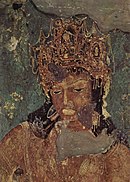Vindhyasena
| Vindhyasena | |
|---|---|
| Dharma-Mahārāja | |
| Reign | c. 355 – 400 CE |
| Predecessor | Sarvasena |
| Successor | Pravarasena II |
| House | Vakataka |
| Vakataka dynasty c. 250 - 510 CE | ||||||||||||||||
|---|---|---|---|---|---|---|---|---|---|---|---|---|---|---|---|---|
| ||||||||||||||||
| Nandivardhana-Pravarapura Branch | ||||||||||||||||
| ||||||||||||||||
| Vatsagulma Branch | ||||||||||||||||
| ||||||||||||||||
|
Vindhyasena (r. c. 355 – 400 CE[1]), also known as Vindhyashakti II,[2] was a ruler of the Vatsagulma branch of the Vakataka dynasty. He was the son and successor of Sarvasena I.
Vindhyasena seems to have enjoyed quite a long reign, as he issued a charter from his capital of Vatsagulma in his thirty-seventh regnal year.[3] The charter records the grant of a village in the Nandikata region which is identified with Nanded. An inscription at Ajanta from the time of Harishena, a later Vakataka monarch, records Vindhyasena's victory against the rulers of the Kuntala in northern Karnataka, likely the Kadambas.[4] Vindhyasena ruled over a fairly extensive kingdom that included the southern part of Berar (Vidarbha) and the districts of Nasik, Ahmednagar, Pune, and Satara,[5] as well as the Marathwada region.[4]
Vindhyasena's contemporary to the north was his cousin Prithivishena I of the main Vakataka branch. The relationship between the two branches of the dynasty appears to have been quite cordial at this time, with the main branch probably enjoying a nominal overlordship over the Vatsagulma branch.[6] Prithivishena likely provided material aid to Vindhyasena as the latter carried out the conquest of the Kuntala country.[7] Upon his death, Vindhyasena was succeeded by his son Pravarasena II.[5]
References
- ^ Shastri, Ajay Mitra (1997). Vakatakas: Sources and History. Aryan Books International. p. 212. ISBN 9788173051234.
- ^ A.S. Altekar (1960). Yazdani, Ghulam (ed.). The Early History of the Deccan. Oxford University Press. p. 186.
- ^ D.C. Sircar (1997). Majumdar, R.C. (ed.). The Classical Age (Fifth ed.). Bharatiya Vidya Bhavan. p. 185.
- ^ a b Singh, Upinder (2009). A history of ancient and early medieval India : from the Stone Age to the 12th century. New Delhi: Pearson Longman. p. 484. ISBN 978-81-317-1677-9. Retrieved 10 August 2016.
- ^ a b A.S. Altekar (2007). Majumdar, R.C.; Altekar, A.S. (eds.). The Vakataka-Gupta Age. Motilal Banarsi Dass. p. 111. ISBN 9788120800434.
- ^ Altekar (2007), pp. 100, 111
- ^ Altekar (1960), p. 172












